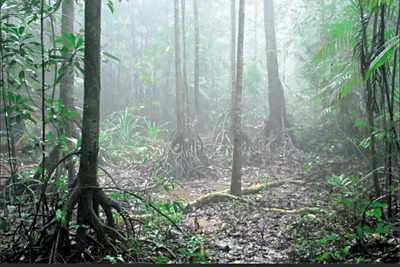
The researchers have suggested a large-scale project to conduct further research on the Myristica swamps in the Western Ghats, to strengthen conservation and restoration efforts. Comprehensive documentation of these remaining swamps, species and their genetic diversity, and local threats, will allow better protection of these remnant forests.
MANGALURU: Researchers have suggested a large-scale project to conduct further research on the Myristica swamps in the Western Ghats, in order to strengthen conservation and restoration efforts. Comprehensive documentation of these remaining swamps, species and their genetic diversity, and local threats, will allow better protection of these remnant forests.
Ecology experts Priya Ranganathan, G Ravikanth and NA Aravind from Ashoka Trust for Research in Ecology and the Environment (ATREE) reviewed the research and conservation of Myristica swamps, which are tree-covered wetlands within the evergreen forests of the Western Ghats. He has recommended a clear policy for swamp conservation involving local communities as well as the forest department. “Swamps should be declared as Community Conservation Areas, and conservation work should focus on the restoration of degraded swamps and their biodiversity elements. In addition, encroached land that is currently under alternative land use should be restored to its original Habitat should be restored, and the quality of watersheds in these areas should be revived,” said NA Arvind.
The swamps of the Western Ghats are home to many rare-relict oristic and faunal taxa, including many endemic and threatened species. One of the most unique and primitive ecosystems, they once formed a large hydrological network, but due to increased human pressure, they now exist as small isolated pockets, and are among the most threatened ecosystems in India. are one of The Western Ghats is one of the 36 global biodiversity hotspots, which occupy less than 6% of India’s landmass. Despite its high biodiversity, only 9% of the Western Ghats comes under Protected Area Network (PA).
Arvind said that Myristica swamps are more prone to destruction than other evergreen forest types. “Freshwater marshes fall under the umbrella category of ‘ecologically sensitive areas’, areas that are biologically and ecologically rich, unique, valuable and largely irreplaceable when destroyed. Many of the Myristica swamps form the PA network of India. Although some swamps in Kerala and Karnataka are in protected forest landscape. The Biodiversity Act of 2002 declares important biodiversity areas, including the Myristica swamps, as biodiversity heritage sites. A site-based initiative is yet to be taken by the U.K. Forest Department and the State Biodiversity Board of Karnataka, where most of these marshes still exist today.
Ravikant also feels that there are notable research gaps, especially when it comes to hydrology, soil studies and ecosystem services provided by these swamps, and that further research is needed for a comprehensive understanding of these unique water bodies. .
FacebookTwitterLinkedinE-mail
.